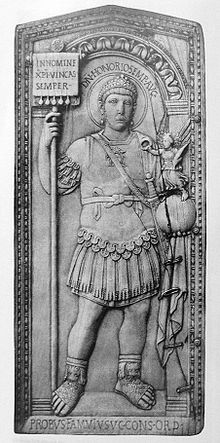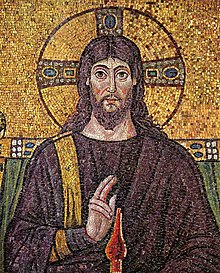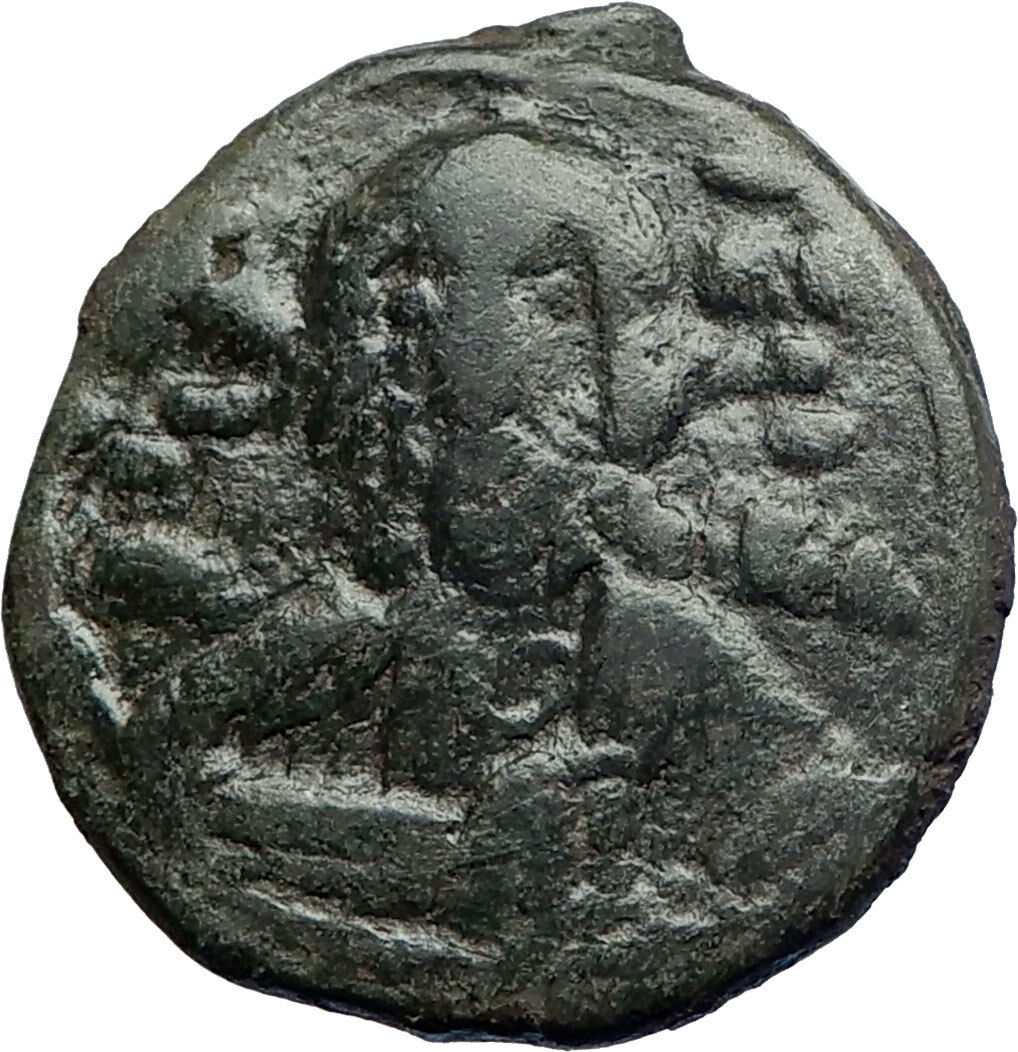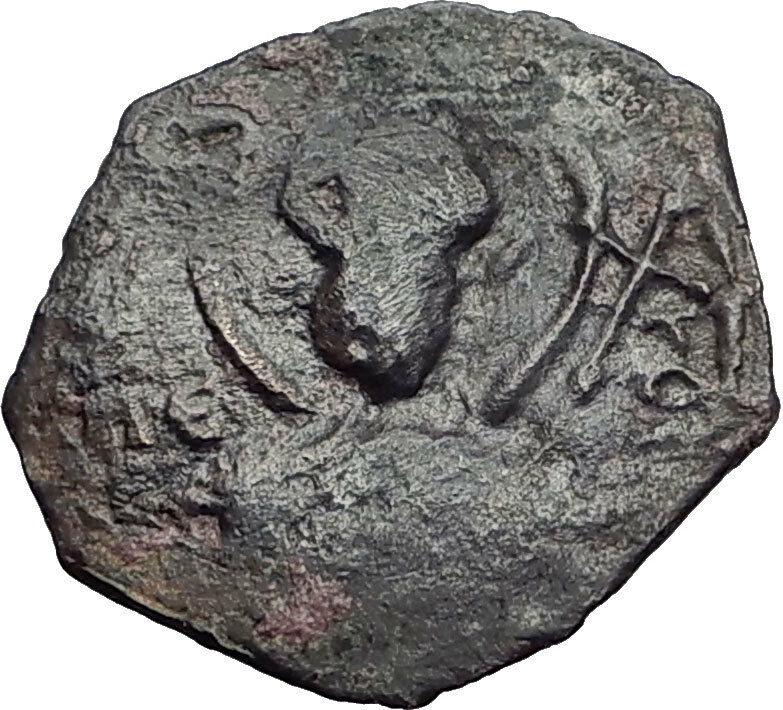|
Michael VII Ducas
Byzantine Emperor
:
October 24, 1071 –
March 24, 1078 A.D.
Bronze Follis 28mm (6.82 grams) Constantinople mint: 1071-1078 A.D.
Reference: Sear 1878
Bust of
Christ
facing, cross behind head, wearing pallium and colobium,
and raising right hand
in benediction; in left hand, book of Gospels; in field,
above transverse limbs
of cross, IC – XC; beneath limbs, large star on either
side of bust.
+ MIXAHΛ RACIΛ O Δ, Bust facing, bearded, wearing
crown and loros, and
holding
labarum
and globe cross.
You are bidding on the exact
item pictured, provided with a Certificate of Authenticity and Lifetime
Guarantee of Authenticity.

Labarum of Constantine I, displaying the “Chi-Rho” symbol above.
The labarum was a
vexillum
(military standard) that displayed
the “Chi-Rho”
symbol
☧
, formed from the first two
Greek letters
of the word “Christ”
—
Chi
and
Rho
. It was first used by the
Roman emperor
Constantine I
. Since the vexillum consisted of
a flag suspended from the crossbar of a cross, it was ideally suited to
symbolize the
crucifixion
of
Christ
.
Later usage has sometimes regarded the terms “labarum” and “Chi-Rho” as
synonyms. Ancient sources, however, draw an unambiguous distinction between the
two.
Etymology
Beyond its derivation from Latin labarum, the etymology of the word is
unclear. Some derive it from Latin /labāre/ ‘to totter, to waver’ (in the sense
of the “waving” of a flag in the breeze) or laureum [vexillum] (“laurel
standard”). According to the
Real Academia Española
, the related
lábaro
is also derived from Latin labărum
but offers no further derivation from within Latin, as does the Oxford English
Dictionary.[5]
An origin as a loan into Latin from a Celtic language or
Basque
has also been postulated. There is a
traditional Basque symbol called the
lauburu
; though the name is only attested from
the 19th century onwards the motif occurs in engravings dating as early as the
2nd century AD.
Vision of Constantine

A coin of Constantine (c.337) showing a depiction of his labarum
spearing a serpent.
On the evening of October 27, 312, with his army preparing for the
Battle of the Milvian Bridge
, the emperor
Constantine I
claimed to have had a vision
which led him to believe he was fighting under the protection of the
Christian God
.
Lactantius
states that, in the night before the
battle, Constantine was commanded in a dream to “delineate the heavenly sign on
the shields of his soldiers”. He obeyed and marked the shields with a sign
“denoting Christ”. Lactantius describes that sign as a “staurogram”, or a
Latin cross
with its upper end rounded in a
P-like fashion, rather than the better known
Chi-Rho
sign described by
Eusebius of Caesarea
. Thus, it had both the
form of a cross and the monogram of Christ’s name from the formed letters “X”
and “P”, the first letters of Christ’s name in Greek.
From Eusebius, two accounts of a battle survive. The first, shorter one in
the
Ecclesiastical History
leaves no doubt that
God helped Constantine but doesn’t mention any vision. In his later Life of
Constantine, Eusebius gives a detailed account of a vision and stresses that
he had heard the story from the emperor himself. According to this version,
Constantine with his army was marching somewhere (Eusebius doesn’t specify the
actual location of the event, but it clearly isn’t in the camp at Rome) when he
looked up to the sun and saw a cross of light above it, and with it the Greek
words
Ἐν Τούτῳ Νίκα
. The traditionally employed
Latin translation of the Greek is
in hoc signo vinces
— literally “In this
sign, you will conquer.” However, a direct translation from the original Greek
text of Eusebius into English gives the phrase “By this, conquer!”
At first he was unsure of the meaning of the apparition, but the following
night he had a dream in which Christ explained to him that he should use the
sign against his enemies. Eusebius then continues to describe the labarum, the
military standard used by Constantine in his later wars against
Licinius
, showing the Chi-Rho sign.
Those two accounts can hardly be reconciled with each other, though they have
been merged in popular notion into Constantine seeing the Chi-Rho sign on the
evening before the battle. Both authors agree that the sign was not readily
understandable as denoting Christ, which corresponds with the fact that there is
no certain evidence of the use of the letters chi and rho as a Christian sign
before Constantine. Its first appearance is on a Constantinian silver coin from
c. 317, which proves that Constantine did use the sign at that time, though not
very prominently. He made extensive use of the Chi-Rho and the labarum only
later in the conflict with Licinius.
The vision has been interpreted in a solar context (e.g. as a
solar halo
phenomenon), which would have been
reshaped to fit with the Christian beliefs of the later Constantine.
An alternate explanation of the intersecting celestial symbol has been
advanced by George Latura, which claims that Plato’s visible god in Timaeus
is in fact the intersection of the Milky Way and the Zodiacal Light, a rare
apparition important to pagan beliefs that Christian bishops reinvented as a
Christian symbol.
Eusebius’ description of the labarum
“A Description of the Standard of the Cross, which the Romans now call the
Labarum.” “Now it was made in the following manner. A long spear, overlaid with
gold, formed the figure of the cross by means of a transverse bar laid over it.
On the top of the whole was fixed a wreath of gold and precious stones; and
within this, the symbol of the Saviour’s name, two letters indicating the name
of Christ by means of its initial characters, the letter P being intersected by
X in its centre: and these letters the emperor was in the habit of wearing on
his helmet at a later period. From the cross-bar of the spear was suspended a
cloth, a royal piece, covered with a profuse embroidery of most brilliant
precious stones; and which, being also richly interlaced with gold, presented an
indescribable degree of beauty to the beholder. This banner was of a square
form, and the upright staff, whose lower section was of great length, of the
pious emperor and his children on its upper part, beneath the trophy of the
cross, and immediately above the embroidered banner.”
“The emperor constantly made use of this sign of salvation as a safeguard
against every adverse and hostile power, and commanded that others similar to it
should be carried at the head of all his armies.”
Iconographic career under Constantine

Coin of
Vetranio
, a soldier is holding two
labara. Interestingly they differ from the labarum of Constantine in
having the Chi-Rho depicted on the cloth rather than above it, and
in having their staves decorated with
phalerae
as were earlier Roman
military unit standards.

The emperor
Honorius
holding a variant of the
labarum – the Latin phrase on the cloth means “In the name of Christ
[rendered by the Greek letters XPI] be ever victorious.”
Among a number of standards depicted on the
Arch of Constantine
, which was erected, largely
with fragments from older monuments, just three years after the battle, the
labarum does not appear. A grand opportunity for just the kind of political
propaganda that the Arch otherwise was expressly built to present was missed.
That is if Eusebius’ oath-confirmed account of Constantine’s sudden,
vision-induced, conversion can be trusted. Many historians have argued that in
the early years after the battle the emperor had not yet decided to give clear
public support to Christianity, whether from a lack of personal faith or because
of fear of religious friction. The arch’s inscription does say that the Emperor
had saved the
res publica
INSTINCTV DIVINITATIS
MENTIS MAGNITVDINE (“by greatness of mind and by instinct [or impulse]
of divinity”). As with his predecessors, sun symbolism – interpreted as
representing
Sol Invictus
(the Unconquered Sun) or
Helios
,
Apollo
or
Mithras
– is inscribed on his coinage, but in
325 and thereafter the coinage ceases to be explicitly pagan, and Sol Invictus
disappears. In his
Historia Ecclesiae
Eusebius further reports
that, after his victorious entry into Rome, Constantine had a statue of himself
erected, “holding the sign of the Savior [the cross] in his right hand.” There
are no other reports to confirm such a monument.
Whether Constantine was the first
Christian
emperor supporting a peaceful
transition to Christianity during his rule, or an undecided pagan believer until
middle age, strongly influenced in his political-religious decisions by his
Christian mother
St. Helena
, is still in dispute among
historians.
As for the labarum itself, there is little evidence for its use before 317.In
the course of Constantine’s second war against Licinius in 324, the latter
developed a superstitious dread of Constantine’s standard. During the attack of
Constantine’s troops at the
Battle of Adrianople
the guard of the labarum
standard were directed to move it to any part of the field where his soldiers
seemed to be faltering. The appearance of this talismanic object appeared to
embolden Constantine’s troops and dismay those of Licinius.At the final battle
of the war, the
Battle of Chrysopolis
, Licinius, though
prominently displaying the images of Rome’s pagan pantheon on his own battle
line, forbade his troops from actively attacking the labarum, or even looking at
it directly.[16]
Constantine felt that both Licinius and
Arius
were agents of Satan, and associated them
with the serpent described in the
Book of Revelation
(12:9).
Constantine represented Licinius as a snake on his coins.
Eusebius stated that in addition to the singular labarum of Constantine,
other similar standards (labara) were issued to the Roman army. This is
confirmed by the two labara depicted being held by a soldier on a coin of
Vetranio
(illustrated) dating from 350.
Later usage

Modern ecclesiastical labara (Southern Germany).

The emperor
Constantine Monomachos
(centre
panel of a Byzantine enamelled crown) holding a miniature labarum
Jesus of Nazareth (c. 5 BC/BCE – c. 30 AD/CE), also
referred to as Jesus Christ or simply Jesus, is the central figure
of
Christianity. Most
Christian denominations
venerate him as
God the
Son
incarnated
and believe that he
rose from the dead
after being
crucified
.

The
principal sources of information regarding Jesus are the four
canonical gospels, and most
critical scholars
find them, at least the
Synoptic Gospels, useful for reconstructing Jesus’ life and
teachings. Some scholars believe apocryphal texts such as the
Gospel of Thomas and the
Gospel according to the Hebrews
are also
relevant
.
Most critical historians agree that Jesus was a
Jew
who was regarded as a teacher and
healer
, that he
was baptized
by
John the Baptist, and
was crucified
in
Jerusalem
on the orders of the
Roman Prefect
Judaea,
Pontius Pilate, on the charge of
sedition
against the Roman Empire
. Critical Biblical scholars and
historians have offered competing descriptions of Jesus as a self-described
Messiah,
as the leader of an apocalyptic movement, as an itinerant sage, as a charismatic
healer, and as the founder of an independent religious movement. Most
contemporary scholars of the
Historical Jesus consider him to have been an independent,
charismatic founder of a Jewish restoration movement, anticipating an imminent
apocalypse. Other prominent scholars, however, contend that Jesus’ “Kingdom
of God” meant radical personal and social transformation instead of a
future apocalypse.
Christians traditionally believe that Jesus was
born of a virgin
:529–32
performed
miracles
,:358–59
founded
the Church
,
rose from the dead
, and
ascended
into
heaven,:616–20
from which he
will return
.:1091–109
Most Christian scholars today present Jesus as the awaited Messiah promised in
the
Old Testament and as God, arguing that he fulfilled many Messianic
prophecies of the Old Testament
. The majority of Christians
worship Jesus as the incarnation of God the Son, one of three divine persons of
a reject Trinitarianism
Trinity, wholly or partly,
believing it to be non-scriptural.
Michael VII Doukas or Ducas (Greek:
Μιχαήλ Ζ΄ Δούκας, Mikhaēl VII Doukas), nicknamed Parapinakēs (Παραπινάκης),
was
Byzantine emperor
from 1071 to 1078.
Life
Michael VII was the eldest son of
Constantine X Doukas
and
Eudokia Makrembolitissa
, and was born c. 1050,
in Constantinople
. He had been associated with his
father on the throne late in 1059, together with or shortly before his newly
born brother
Konstantios Doukas
. When Constantine X died in
1067, Michael VII was 17 years old and should have been able to rule by himself.
He exhibited little interest in politics, and his mother Eudokia and uncle John
Doukas governed the empire as effective regents.
On January 1, 1068, Eudokia married the general
Romanos Diogenes
, who now became senior
co-emperor alongside Michael VII, Konstantios, and another brother,
Andronikos
. When Romanos IV was defeated and
captured by Alp Arslan
of the
Seljuk Turks
at the
Battle of Manzikert
in August 1071, Michael VII
remained in the background, while the initiative was taken by his uncle
John Doukas
and his tutor
Michael Psellos
. They conspired to keep Romanos
from regaining power after his release from captivity, while he himself felt
under no obligation to honor the agreement that Romanus struck with the Sultan.
After the dispatch of Eudokia to a monastery, Michael VII was crowned again on
October 24, 1071 as senior emperor.
Although still advised by Michael Psellos and John Doukas, Michael VII became
increasingly reliant on his finance minister
Nikephoritzes
. The emperor’s chief interests,
shaped by Psellos, were in academic pursuits, and he allowed Nikephoritzes to
increase both taxation and luxury spending without properly financing the army.
As an emperor he was incompetent, and surrounded by synchophantic court
officials, he was blind to the empire collapsing around him. In dire straits,
imperial officials resorted to property confiscations and even expropriated some
of the wealth of the church. The underpaid army tended to mutiny, and the
Byzantines lost Bari
, their last possession in
Italy
, to the
Normans
of
Robert Guiscard
in 1071. Simultaneously, they
faced a serious revolt in the Balkans, where they faced an attempt for the
restoration of the
Bulgarian
state in the same year. Although this
revolt was suppressed by the general Nikephoros Bryennios, the Byzantine Empire
was unable to recover its losses in
Asia Minor
.
After Manzikert, the Byzantine government sent a new army to contain the
Seljuk Turks
under Isaac Komnenos, a brother of
the future emperor
Alexios I Komnenos
, but this army was defeated
and its commander captured in 1073. The problem was made worse by the desertion
of the Byzantines’ western mercenaries, who became the object of the next
military expedition in the area, led by the
Caesar John Doukas
. This campaign also ended in
failure and its commander was likewise captured by the enemy. The victorious
mercenaries now forced John Doukas to stand as pretender to the throne. In this
situation Michael VII’s government was forced to recognize the conquests of the
Seljuk Turks
in
Asia Minor
in 1074, and to seek their support.
A new army under Alexios Komnenos, reinforced by Seljuk troops sent by
Malik Shah I
, finally defeated the mercenaries
and captured John Doukas in 1074.
These misfortunes caused widespread dissatisfaction, exacerbated by the
devaluation of the currency, which gave the emperor his nickname Parapinakēs,
“minus a quarter”. In 1078 two generals,
Nikephoros Bryennios
and
Nikephoros Botaneiates
, simultaneously revolted
in the Balkans and Anatolia, respectively. Botaneiates gained the support of the
Seljuk Turks and first reached Constantinople. Michael VII resigned the throne
with hardly a struggle on March 31, 1078 and retired into the monastery of
Stoudios
. He later became metropolitan
archbishop of Ephesus
and died in Constantinople in c. 1090.
Usurpers
Various usurpers attempted to overthrow Michael VII or rule parts of the
empire. These included:
- Nestor – A slave of
Constantine X
, he had been promoted to the
rank of governor on the towns on the Danube. He rebelled in around 1073,
placing himself at the head of the garrisons under his command, which were
already in a state of mutiny due to an arrears in their pay. The troops were
eager to plunder the Bulgarians, and he obtained the assistance of one of
the chiefs of the Patzinaks before marching onto
Constantinople
. The rebels demanded the
dismissal of minister Nikephoritzes, but discovering that he didn’t have the
numbers to attack the capital, his troops separated into smaller parties,
and proceeded to plunder the countryside. Nestor remained with the Patzinaks,
and retreated with them beyond the
Danube
.
-
Philaretos Brachamios
-
Caesar John Doukas
-
Nikephoros Bryennios
-
Nikephoros Botaneiates
Family
Michael VII Doukas had married
Maria of Alania
, daughter of King
Bagrat IV of Georgia
. By her he had at least
one son,
Constantine Doukas
, co-emperor from c. 1075 to
1078 and from 1081 to 1087/8. He died c. 1095.
|















